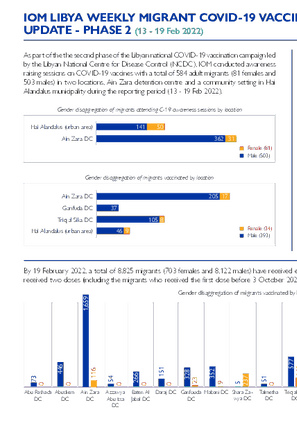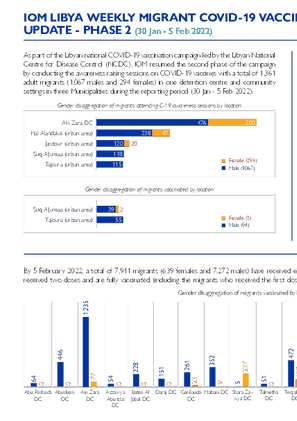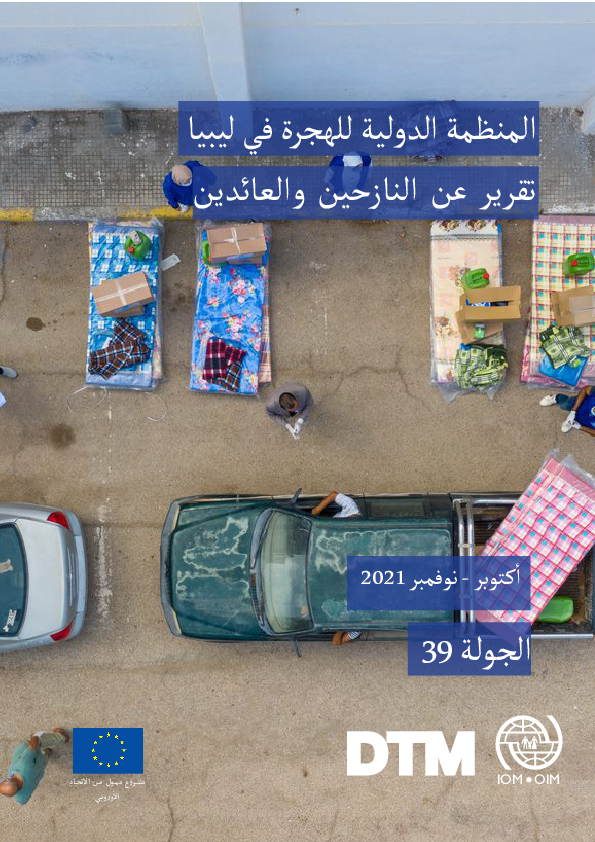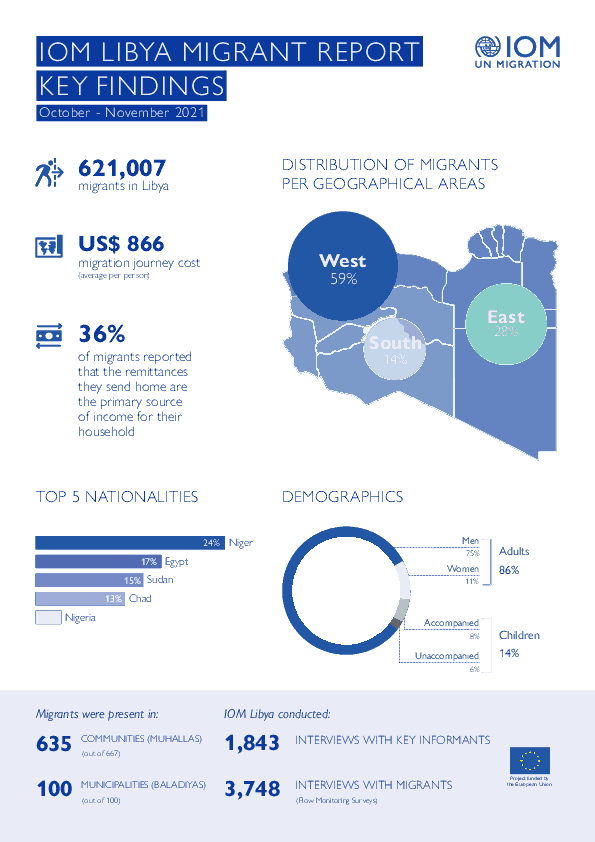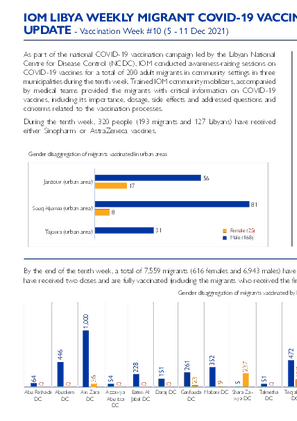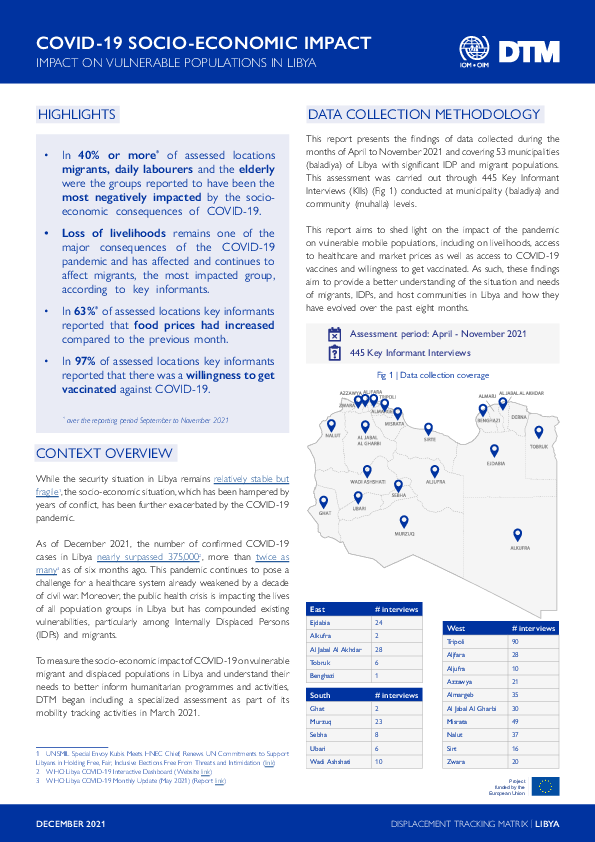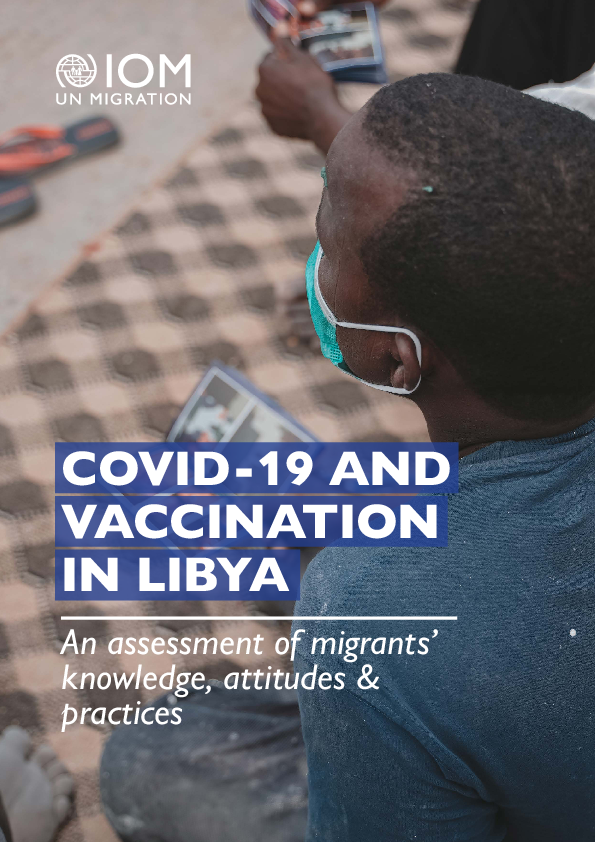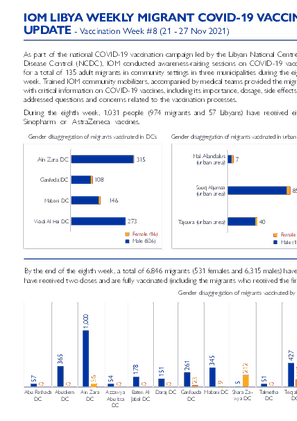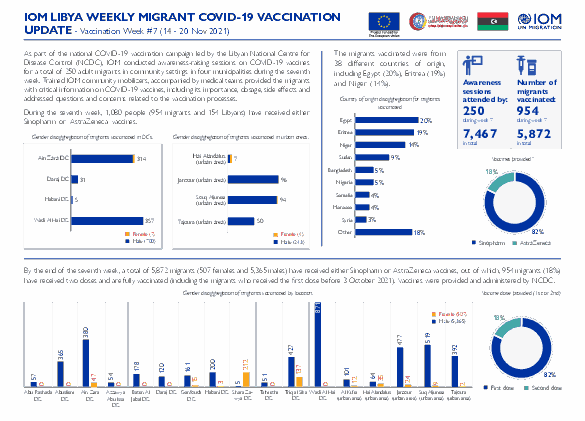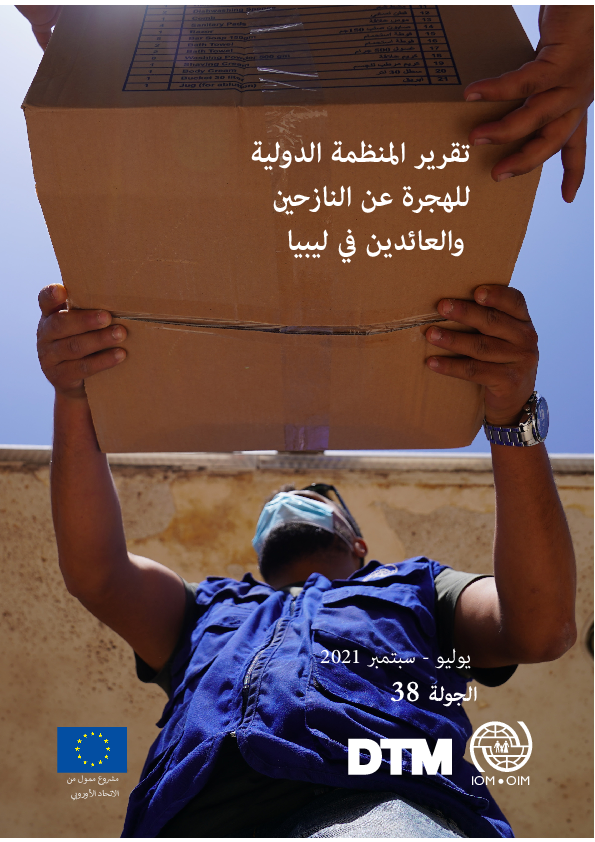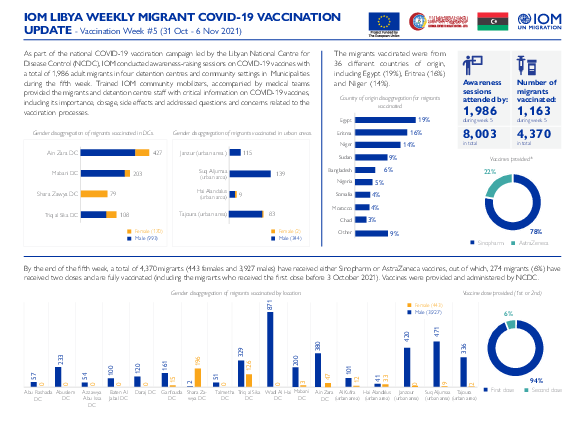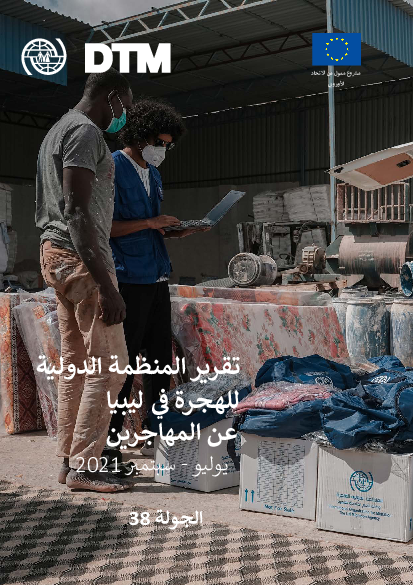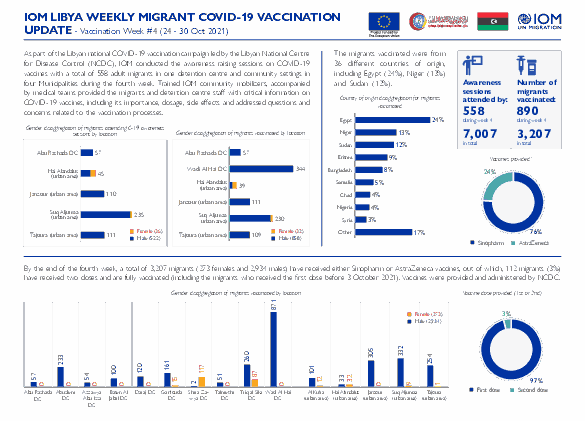-
Countries
-
Data and Analysis
-
Special Focus
-
Crisis Responses
Libya
Error message
The submitted value field_published_date_value in the Sort by element is not allowed.
About Libya
Libya is a geographically vast country with several regions that are difficult to access. In order to understand the full scope of humanitarian assistance that is needed throughout the country, IOM established the Displacement Tracking Matrix (DTM) programme in 2016 in order to provide a common operating picture concerning the movement of populations in Libya, allowing humanitarian actors to provide timely assistance to those in need. Following the escalation of conflict and insecurity in 2014, the security situation has remained volatile since with fluctuations in the intensity of localized clashes. Congruently, conflict has caused new displacements, often in areas ill-equipped to accommodate large population movements while also negatively impacting the large migrant population residing and transiting through Libya. More recently, the capital Tripoli was heavily affected by displacement waves in September 2018 and April 2019.
DTM’s mobility tracking and flow monitoring activities identified many migrants in-country to be in need of various forms of assistance. Libya’s geographic location, resources and work opportunities has made it both a country of destination and transit for migrants for many years. Despite the deterioration of the security situation since 2011 migrants continue coming to and transiting through Libya, the majority from Sub-Saharan and North African countries.
In this complex operating environment, DTM Libya has been providing a common operating picture concerning the movement of populations in Libya since 2016, allowing humanitarian actors to provide timely assistance to those in need. Through its mobility tracking, flow monitoring and needs assessment activities, DTM Libya has established itself as data hub for quantitative data on migratory flows to and within Libya, migrant presence in Libya disaggregated by nationality and area, as well as humanitarian needs of migrants, internally displaced population and returnees. All activities are implemented through periodical bi-monthly data collection cycles, allowing trend analysis over time to provide evidence-base for both policy-level discussions and to guide humanitarian action.
In order to facilitate humanitarian interventions, DTM works closely with IOM’s other programmes through referring identified populations in need of assistance at flow monitoring points to IOM’s Direct Assistance, Health, Voluntary Humanitarian Return (VHR), Protection and Migrant Rapid Response Mechanism (MRRM) programmes. Furthermore, DTM Libya supports other humanitarian partners through providing emergency tracking updates in case of sudden population movements as well as facilitating humanitarian assessments for the Rapid Response Mechanism (RRM) jointly implemented by IOM, UNICEF, WFP and UNFPA.
For more information on IOM's activities in Libya, please visit the IOM Libya country office website.
Contact
DTM Libya
DTMLibya@iom.int
Current Donors
- EUTF
Libya — Weekly Migrant COVID-19 Vaccination Update - Phase 2 (20 - 26 Feb 2022)
As part of the the second phase of the Libyan national COVID-19 vaccination campaign led by the Libyan National Centre for Disease Control (NCDC), IOM conducted awareness raising sessions on COVID-19 vaccines with a total of 566 adult migrants (52 females and 514 males) in four locations, Ain Zar
Libya — Weekly Migrant COVID-19 Vaccination Update - Phase 2 (13 - 19 Feb 2022)
As part of the the second phase of the Libyan national COVID-19 vaccination campaign led by the Libyan National Centre for Disease Control (NCDC), IOM conducted awareness raising sessions on COVID-19 vaccines with a total of 584 adult migrants (81 females and 503 males) in two locations, Ain Zara
Libya — Weekly Migrant COVID-19 Vaccination Update - Phase 2 (6 - 12 Feb 2022)
As part of the Libyan national COVID-19 vaccination campaign led by the Libyan National Centre for Disease Control (NCDC), IOM resumed the second phase of the campaign by conducting the awareness raising sessions on COVID-19 vaccines with a total of 644 adult migrants (619 males and 25 females) i
Libya — Weekly Migrant COVID-19 Vaccination Update - Phase 2 (30 Jan - 5 Feb 2022)
As part of the Libyan national COVID-19 vaccination campaign led by the Libyan National Centre for Disease Control (NCDC), IOM resumed the second phase of the campaign by conducting the awareness raising sessions on COVID-19 vaccines with a total of 1,361 adult migrants (1,067 males and 294 femal
Libya — IDP and Returnee Report 39 (October -November 2021) [Arabic]
يعرض هذا التقرير البيانات المجمّعة فيما بين شهري أكتوبر ونوفمبر من سنة 2021 حول النازحين داخليا والعائدين. وتمثّل هذه البيانات والمستخلصات الجولة 39 من تتبع التنقل في ليبيا التي أجرتها مصفوفة تتبع النزوح.
Libya — IDP and Returnee Key Findings Report 39 (October- November 2021)
This infographic presents the key findings of Round 39 of the mobility tracking component of the Displacement Tracking Matrix (DTM) programme in Libya.
Libya — IDP and Returnee Report 39 (October- November 2021)
This report presents the data on internally displaced persons (IDPs) and returnees between October – November 2021. The data and findings represent round 39 of the Displacement Tracking Matrix’s (DTM) Mobility Tracking.
Migrant Report Key Findings 39 (October - November 2021)
This infographic presents the key findings of Round 39 of the mobility tracking component of the Displacement Tracking Matrix (DTM) programme in Libya.
Libya — Migrant Report 39 (October - November 2021)
DTM Libya identified a total of 621,007 migrants from over 43 nationalities in the 100 Libyan municipalities during Round 39 of data collection (October – November 2021). In line with a trend which started at the beginning of 2021, the number of migrants in Libya has continued to increase d
Libya — Detention Centre Profile Generator (December 2021)
Detention Centre Profiling is a component of IOM Libya’s Displacement Matrix programme. It is a data oriented tool that routinely provides specific sex and age demographic data and key sectorial information on individuals held in Libya’s detention Centres on the date of assessment.
Libya — Weekly Migrant COVID-19 Vaccination Update (12 - 18 Dec 2021)
As part of the national COVID-19 vaccination campaign led by the Libyan National Centre for Disease Control (NCDC), IOM community mobilizers, accompanied by medical teams vaccinated migrants at Ain Zara detention center (DC).
Libya — Detention Centre Profile Generator (November 2021)
Detention Centre Profiling is a component of IOM Libya’s Displacement Matrix programme. It is a data oriented tool that routinely provides specific sex and age demographic data and key sectorial information on individuals held in Libya’s detention Centres on the date of assessment.
Libya — Weekly Migrant COVID-19 Vaccination Update (5 - 11 Dec 2021)
As part of the national COVID-19 vaccination campaign led by the Libyan National Centre for Disease Control (NCDC), IOM conducted awareness-raising sessions on COVID-19 vaccines for a total of 200 adult migrants in community settings in three municipalities during the tenth week.
COVID-19 Socio-Economic Impact In Libya (April - November 2021)
This report presents the findings of data collected during the months of April to November 2021 and covering 53 municipalities (baladiya) of Libya with significant IDP and migrant populations.
Libya — Weekly Migrant COVID-19 Vaccination Update (28 Nov - 4 Dec 2021)
As part of the national COVID-19 vaccination campaign led by the Libyan National Centre for Disease Control (NCDC), IOM conducted awareness-raising sessions on COVID-19 vaccines for a total of 305 adult migrants in community settings in three municipalities during the ninth week.
COVID-19 and Vaccination in Libya – An assessment of migrants’ knowledge, attitudes & practices
COVID-19 and Vaccination in Libya – An assessment of migrants’ knowledge, attitudes & practices report sheds light on what migrants know about COVID-19 pandemic, their beliefs and practices in relation to COVID-19 with an aim to inform risk communication and community engagement (RCCE) activi
Libya — Weekly Migrant COVID-19 Vaccination Update (21 - 27 Nov 2021)
As part of the national COVID-19 vaccination campaign led by the Libyan National Centre for Disease Control (NCDC), IOM conducted awareness-raising sessions on COVID-19 vaccines for a total of 135 adult migrants in community settings in three municipalities during the eighth week.
Libya — Weekly Migrant COVID-19 Vaccination Update (14 - 20 Nov 2021)
As part of the national COVID-19 vaccination campaign led by the Libyan National Centre for Disease Control (NCDC), IOM conducted awareness-raising sessions on COVID-19 vaccines for a total of 250 adult migrants in community settings in four municipalities during the seventh week.
Libya — Weekly Migrant COVID-19 Vaccination Update (7 - 13 Nov 2021)
As part of the national COVID-19 vaccination campaign led by the Libyan National Centre for Disease Control (NCDC), IOM conducted awareness-raising sessions on COVID-19 vaccines for a total of 210 adult migrants in community settings in four municipalities during the sixth week.
Libya — Detention Centre Profile Generator (October 2021)
Detention Centre Profiling is a component of IOM Libya’s Displacement Matrix programme. It is a data oriented tool that routinely provides specific sex and age demographic data and key sectorial information on individuals held in Libya’s detention Centres on the date of assessment.
Libya — IDP and Returnee Report 38 (July – September 2021) [Arabic]
يعرض هذا التقرير البيانات المجمّعة فيما بين شهري يوليو وسبتمبر من سنة 2021 حول النازحين داخليا والعائدين. وتمثّل هذه البيانات والمستخلصات الجولة 38 من تتبع التنقل في ليبيا التي أجرتها مصفوفة تتبع النزوح.
Libya — Weekly Migrant COVID-19 Vaccination Update (31 Oct - 06 Nov 2021)
As part of the national COVID-19 vaccination campaign led by the Libyan National Centre for Disease Control (NCDC), IOM conducted awareness-raising sessions on COVID-19 vaccines with a total of 1,986 adult migrants in four detention centres and community settings in Municipalities during the fift
Libya — Migrant Report 38 (July — September 2021) [Arabic]
أحصت مصفوفة تتبع النزوح في ليبيا وجود إجمالي 610.128 مهاجرا ينحدر أصلهم من أكثر من 44 جنسية وذلك في بلديات ليبيا الـ100 وخلال ما بين شهري يوليو وسبتمبر من سنة 2021 وفي إطار الجولة 38 من تجميع البيانات.
Libya — Weekly Migrant COVID-19 Vaccination Update (24 - 30 Oct 2021)
As part of the Libyan national COVID-19 vaccination campaign led by the Libyan National Centre for Disease Control (NCDC), IOM conducted the awareness raising sessions on COVID-19 vaccines with a total of 558 adult migrants in one detention centre and community settings in four Municipalities dur
Pagination
Pagination
- First page
- Previous page
- 1
- 2
- 3
- 4
- 5



